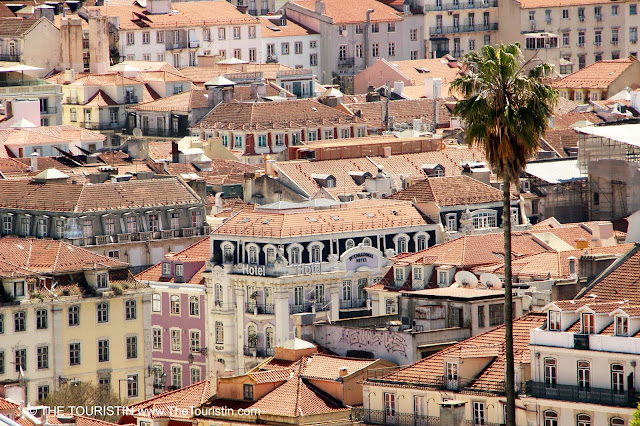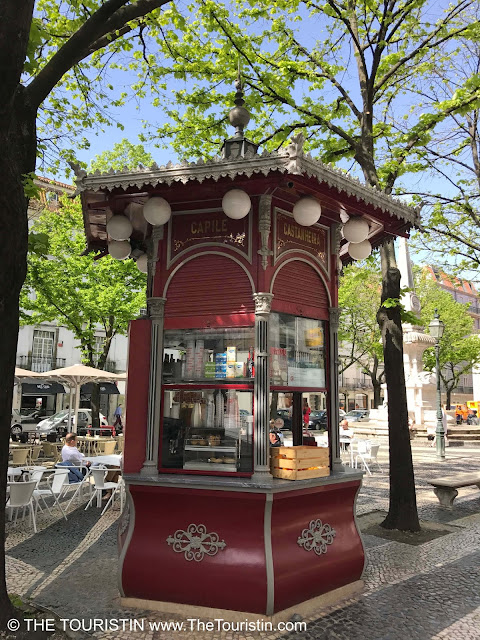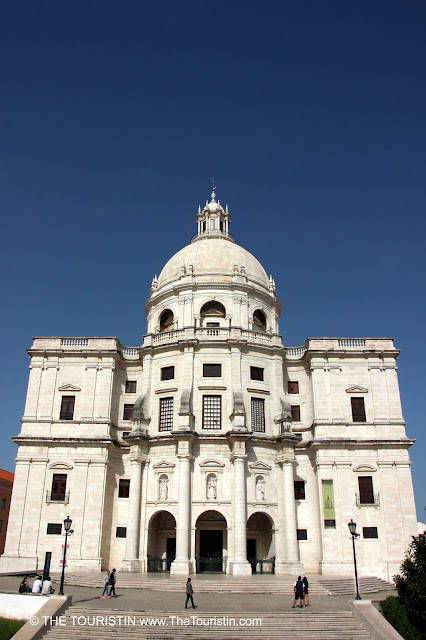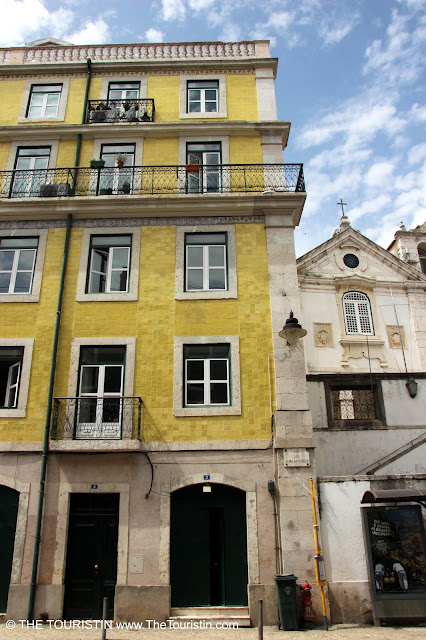You find Portugal at the southwestern tip of Europe. The country lived under an authoritarian regime from 1933 to 1974, but these times are long gone. Seemingly everybody wants to travel to the capital Lisbon these days. Cobbled lanes, beautifully tiled facades, grand squares, and a stunning waterfront. One could surely spend months in Lisbon without having seen the whole town. It is here where you will find something fetching on every street corner. The town is a true beauty. I love that trends and traditions mix so well in Lisbon. Lisbon is small enough so that you can see most of the town on foot. Just keep on walking, and kiss the earth with every single step. When I landed in Lisbon and got off the plane, one of the fellow passengers kissed the tarmac.
You
see a town at its best, and up close with walking everywhere. Here you
find three full-day walks through town; each one is about ten kilometres
long and guides you through all the different areas. Experience the
almost medieval atmosphere in Alfama, browse through the shopping-heaven
Baixa and stroll through trendy Bairro Alto and Chiado with Cais do
Sodre all the way to the design quarter Santos. All suggested walks
start and end on Rua Augusta in the centre of town. You will find lots
of cafes and restaurants everywhere in Lisbon and along the way where
you can have plenty of coffee- and lunch breaks. Please calculate to be
on your feet for around eight to nine hours each day. When you leave
your hotel or apartment for the day at about 9 o'clock, you will be back
by six o'clock. On the walk look out for restaurants you find
attractive, and take their business card. That way you can ring them and
go back there by taxi after you get home from your day's excursion to
have a long relaxing dinner at night.
Day One in Lisbon: Ten kilometres through Lisbon
1. Rua Augusta
Rua Augusta is right in the centre of Lisbon; it is here where you find any store you would find on any other high street in Europe too. There are as well special finds to make, surprisingly beautiful shop fronts that look like little pieces of art.
2. Escalator Santa Justa
Santa Justa, the Neo-Gothic style lift, opened in 1902. It became a national monument of Portugal exactly one hundred years later. Lisbon is a rather hilly city. Use the lift if you can't see yourself walking up the steep Carmo Hill from Baixa district. Whether you walk or use the lift, the structure is a beauteous sight.
Info: Santa Justa Lift, R. do Ouro, Lisbon, Portugal.
3. Rossio Railway Station
The station opened its doors in 1891. The design of the neo-gothic façade is a homage to a style called Manueline, which was the most authentic Portuguese architecture style of early 16th century Portugal. Travellers enter the building through two intertwined stone horseshoes.
Info: Rossio Railway Station. Rossio Square, Lisbon.
4. Rossio Square
Rossio Square is the name of the Pedro IV Square, which has been one of the major squares in town since medieval times. Over the centuries the square hosted riots, festivities, bullfights and even hangings. Today it is a place for kids to play, for friends to meet and for leisurely strolls.
It is in this square that Lisbon's first kiosk opened in 1869. More and more of these small open-air cafes opened all over town, in between they were out of fashion and became a thing of the past. As so often the case with traditional institutions, they are trendy again. These kiosks experienced a revival over recent years and today can be found all over town.
5. Eden Teatro
This has been one of Lisbon’s largest cinemas. Its striking facade on the main city square Praca dos Restauradores is sadly the only thing that most visitors can see today. The cinema that opened its doors in 1931 closed its doors. Probably in a stroke of luck for the building, it has been turned into an apartment hotel at the beginning of the new millennium. It can certainly be told as a sad gentrification-story. Look at it from the bright side. The positive is that the building has been saved from disintegration and for future generations. The question is how Lisbon will be in the future if there are too many hotels and not enough public spaces for locals.
Info: Eden Teatro. Praca dos Restauradores 24, Lisbon, Portugal.
6. Facade of the Ateneu Comercial de Lisboa
The area around this property is considered an important national cultural heritage. This place was the residence of a noble family at the end of the 16th century. It survived the 1755 earthquake and in 1926 it became the Athenaeum, a cultural institution with gymnastic and dance classes, a swimming pool, a library, exhibitions, parties, a business school. Rumours have it that the centre has been managed intentionally improperly so that the insolvency administrator could sell the property to investors. The last one standing was a popular and successful local run alternative bar and restaurant on the first floor. By now the event centre has closed and been sold to a hotel group. It is complicated, food for thought.
Info: R. das Portas de Santo Antão 110, 1150-269 Lisboa, Portugal
7. Glória Elevator
A tram named Glória drives past a Utopia mural on its way from Restauradores Square to São Pedro de Alcântara Belvedere in the Lisbon borough of Bairro Alto. Glória is a national monument in action on 265 meres. Simply fantastic to be surrounded by so much colour in everyday life.
Info: Glória Elevator, between Restauradores Square and São Pedro de Alcântara Belvedere.
8. Viewpoint de São Pedro de Alcântara
Sit down for drinks at one of the kiosk bars in this picture-perfect garden with a view over town.
9. Facades of Bairro Alto during the day
Most people only go here to drink and dance and party during the night. The Bairro Alto is as fun during the night as it is sleepy during the day. Go for a stroll during the day. There are the most beautiful facades to look at and you will be pretty much by yourself.
10. Embaixada
At home in the Ribeiro da Cunha Palace, Embaixada is the place to go to for shopping of Portuguese design and fashion in the trendy neighbourhood of Príncipe Real. Next to all the many small speciality shops is a restaurant/bar in the fairy-tale Moorish-style courtyard.
Info: Embaixada. Praça do Príncipe Real 26, 1250-184 Lisboa, Portugal. Hours: Monday to Sunday 12 to 8pm.
More info: British chef Jamie Oliver is going to open restaurant Jamie’s Italian Lisbon at Praça do Príncipe Real 28, 1250-069 Lisboa, Portugal.
11. Principe Real Garden
The garden was created in the 1800s. It is a tranquil space with a vibrant atmosphere in the Barrio Alto neighbourhood. Sit down on one of the many benches and relax.
12. Bertrand - books, books, books
Bertrand, the oldest operating bookshop in the world, was established in 1732. It's a celebration of authors, illustrators, books and it's a celebration of reading. I love to give books as presents and to read as much as I can and to browse bookshops.
Info: Bertrand. R. Garrett 73, 1200-309 Lisboa, Portugal. Hours: Monday to Saturday 9am to 10pm, Sunday 11am to 10pm.
13. Sunset view of the 25 de Abril Bridge
One sits in a bar at Cais das Colunas, drinks a chilled white Portuguese wine with that distinct floral aroma that the ones from the Douro Valley often have, looks at the sunset and the bridge with that interesting name and can't help but start thinking. The 25 de Abril Bridge spanning the Tagus River connects Lisbon with Almada. The bridge reminds everybody heavily of the Golden Gate Bridge in San Francisco. Building works of the six lanes and 2.7 kilometres Golden Gate Bridge finished in 1937. Building works of the six lanes and 2.2 kilometres 25 de Abril Bridge finished in 1966. The bridge has her name from the revolution that took place on the 25th April 1974 and freed Portugal of its dictatorship. Portugal celebrates this day each year as Freedom Day. While some celebrate freedom, others, who live in freedom, plan to build walls. Others start fighting with a bunch of neighbouring countries, totally neglecting the fact that these 27 are in actual fact their friends.
14. Dinner in Cais do Sodre
In previous decades Cais do Sodre was the place for sailors and prostitutes. Lots of cafes, bars, shops, the food market and the waterfront promenade Ribeira das Naus turned it into the trendy area it is today.
15. Time Out Market – Mercado da Rebeira
If food is your thing, this is the place for you. We all know and love the British Time Out Magazine. They came up with the best idea ever. A market where everything you can eat has been tested by Time Out’s own journalists and critics first. The result is a collection of about 40 food-bars run by Lisbon's most acclaimed chefs. You conveniently find them all together in this pretty food hall. Highly recommended is Felicidade. You can also buy wine to take home, magazines, travel guides, cooking utensils. The shop Toranja is the ideal place to buy a local souvenir; all products are designed and made in Portugal.
Info: Mercado da Rebeira. 481, Av. 24 de Julho, 1200 Lisboa, Portugal Hours: Monday to Saturday 6am to 2am, Sunday 9am to 1pm.
16. Taberna Tosca
Ideally located in the Cais do Sodre on a picturesque church square. Flowery wallpaper, wooden counter and tables, atmospheric lighting plus traditional Portuguese tapas and wine. Yes, please.
Info: Taberna Tosca. Praca de Sao Paulo 21, Lisbon 1200-425, Portugal. Hours: Sunday to Thursday from 12pm to 12am. Friday to Saturday 12pm to 2am.
17. Walk back to Rua Augusta.
--------------------------------------------------
Day Two in Lisbon: Ten kilometres through Lisbon
1. Breakfast at the Kiosk Café on Praça São Paulo
Go to Rua Augusta and walk to one of the oldest kiosks in town, sit down and enjoy the neighbourhood atmosphere with a view of the Parish Church of St. Paul and over the mosaic-style cobbled square.
Info: Praça São Paulo, Lisbon, Portugal.
2. Parish Church of St. Paul in Cais do Sodré
The church was built after the big earthquake in 1755. Go inside to have a look at the impressive painting on the ceiling that shows St Paul glorified as a god-like person.
Info: Parish Church of St. Paul. Praça São Paulo, Lisbon, Portugal.
3. Cais do Sodré Station
The train station right by the river Tejo opened its doors in the summer of 1928. Have a quick look inside; it is well worth a visit.
4. Walk along Ribeira das Naus
This is an old boatyard by the river turned into a city beach (no swimming though). Stroll along the riverbank, watch the ferries, locals, dogs and other tourists go by. The steps that lead down to the river are the perfect place to sit down and eat ice-cream.
5. Arco da Rua Augusta
There were a massive earthquake and a tsunami in 1755 that destroyed almost the whole town. This triumphal arch at the end of Rua Augusta, Lisbon’s busy shopping strip, reminds us of what happened and celebrates how the town obtained new life when it raised from the ashes like a phoenix.
6. Church of St Anthony
The Church of Saint Anthony, built in the 15th century, dedicated to Saint Anthony of Lisbon, is located on the site where the saint was born in 1195. The church was destroyed entirely in the earthquake of 1755. The new building which we see today was built in the exact same spot twelve years after that.
Info: Church of St Anthony. Largo de Santo António da Sé, 1100-401 Lisboa, Portugal.
7. Lisbon Cathedral
Lisbon Cathedral, the oldest place of worship in Lisbon, holds a medieval atmosphere despite the fact that it showcases Romanesque, Gothic, Baroque, as well as Neoclassical architectural styles. The cathedral has got a fascinating history. The facade dates back to the mid-12th century. The first king of Portugal commissioned its construction on the site of a former mosque. As if this wouldn't be enough already, the first bishop was an English crusader.
Info: Lisbon Cathedral. Largo da Sé, 1100-585 Lisboa, Portugal. Hours: Monday to Friday 9am to 7pm. Tickets: Free. The cloister is closed during lunch hours, tickets: EUR 2.50.
8. Resistance Museum - Museu do Aljube - Resistência e Liberdade
One simply cannot skip visiting this place when in Lisbon. This museum documents the struggle against the dictatorship of Portugal from 1926 to 1974. Learn about the resistance and the people who did all they could for freedom and democracy. The museum is on the premises of the former political prison where inmates were tortured. It remains relevant to understand what oppression and fascism are and how it can happen in every country. This place gives us one more amazing opportunity to understand just that. You will soon see that freedom of speech is not the spreading of hate or false news and that it is in our hands to keep peace and freedom. The more we learn and know the better the decisions we make in general elections.
Info: Museu do Aljube. Rua Augusto Rosa 42, Lisbon 100 – 059, Portugal. Tickets: Adults EUR 3. Free entrance: Sunday morning until 2pm. Bank holidays from 10am to 2pm; 18th May (International Museum Day); Children up to 12 years old; Students; Researchers and accredited professors; Journalists and tourism professionals. Hours: Tuesday to Sunday from 10 am to 6 pm. Closed Monday and following bank holidays 1st January, 1st May, 25th December.
9. Miradouro de Santa Luzia
This free observation deck offers the most beautiful view over the Lisbon borough of Alfama. The view over the red rooftops, the pastel-coloured houses and the river Tejo from the hilltop certainly is an iconic one. It is a true must-visit photo opportunity.
Info: Miradouro de Santa Luzia. 1100-117 Lisbon, Portugal
10. Walking the streets of Alfama
Owed to its location, Alfama stands unscathed by the earthquake of 1755. Narrow lanes indicate how life in medieval Lisbon was. The smell of freshly cooked food hangs in the air. From one window to the next spans clotheslines full of freshly washed laundry which is left to dry in the bright sunshine. A few cats stroll along the lanes obviously enjoying the slow lifestyle. The next generation tests their balance on their small bicycles. There is the faint barking of dogs somewhere. Smiling people sipping coffee in one of the cafes on the squares.
11. Monastery of São Vicente de Fora
This is one of the finest mannerist buildings, with Romanesque features here and there, in the whole of Portugal. The church was built over several decades in the 16th century when the King of Portugal wanted to erase all Moorish traces. Without further ado, he built the new property on one of their established places of worship dating back to the 12th century. Religion! The roof and the main dome collapsed during the big earthquake in 1755. See how many different types of patterns, decorative designs and sculptural ornaments you can find throughout your visit to the building.
Info: Monastery of São Vicente de Fora. Largo de São Vicente, Lisbon, Portugal. Walk around towards the right of the building and walk through the garden. Hours: Sunday to Saturday: 8am to 1pm and 2pm to 5pm. Tickets: EUR 5.
12. Sunset drinks at Café da Garagem
Walk along the narrow Costa do Castelo, enter the theatre and climb down a few stairs. The view is magnificent, and this place feels hidden. Eat tomato bread with olive oil and have a glass of Portuguese white wine and enjoy the moment. Special.
Info: Café da Garagem. Teatro Taborda. Costa do Castelo, 75. 1100-178 Lisboa, Portugal. Hours: Tuesday to Sunday from 3pm to 12pm, Monday 6pm to 12pm, Friday and Saturday open till 2 am.
13. Walk back to Rua Augusta
--------------------------------------------------
Day Three in Lisbon: Ten kilometres through Lisbon
1. Bica Elevator
Go to Rua Augusta and make your way to the Bica Elevator. Ever since 1892, this funicular goes up and down the hill in the borough of Bica. The vivid 17th and 18th Century houses with balconies and flower pots create a perfect backdrop for a photo. If you visit early in the day you are almost alone. A few locals and cats roam the street and the view is remarkable from up here.
2. Igreja Paroquial das Mercês
This church, built in the 18th century, is a captivating place. It feels as if it would have fallen asleep. I felt welcomed as I entered albeit it seems not to be open to the general public (as the only visitor).
Info: Igreja Paroquial das Mercês Largo de Jesus. 1200-032 Lisbon, Portugal.
3. Assembly of the Republic - São Bento Palace
The today neoclassical building is the home of the Portuguese parliament and used to be the first Benedictine monastery in town.
Info: Sao Bento Palace. Rua de Sao Bento, Lisbon, Portugal.
4. Walking the streets of Lapa
In the 1700s, the nobility and wealthy chose to live in this area. Large beautiful mansions and gardens make it a lovely and quiet neighbourhood. Right in the middle, you find the Basilica da Estrela and the Jardim da Estrela plus a stellar view over the Tejo River.
5. Facades of Santos
Santos-o-Velho is one of the oldest neighbourhoods in Lisbon and often referred to as the design district. Most properties have gloriously tiled facades and stand in stark contrast to the striking modern façade of the IADE University, the largest Design school in Portugal.
6. National Museum of Ancient Art
You can easily spend a few hours looking at paintings, drawings and prints, sculptures, gold and silverware, furniture, ceramics, glassware, maps and art from Portuguese discoveries. Highlights are the work by Dutch painter Hieronymus Bosch “The Temptation of Anthony” and to see what the Portuguese brought back home from their discovery journeys. There is also a cafe with a beautiful garden overlooking the River Tejo.
Info: Museu Nacional de Arte Antiga, R. das Janelas Verdes, 1249-017 Lisboa, Portugal. Hours: Tuesday to Sunday: 10am-6pm. Closed: January 1st, Easter Sunday, May 1st, June 13th and December 25th. Tickets: Adults EUR 6.
7. Le Chat – Sunset
This is the place for a salad and drinks with a sunset view over the River Tejo and Almada. Info: Le Chat. Jardim 9 de Abril 1 | next door to the Museum of Arte Antiga, Lisbon 1249-083, Portugal. Hours: Sunday from 12.30pm to 12am. Monday to Saturday from 12pm to 2am.
8. Entrance to the Metro Baixa Chiado Station
By the entrance to the Metro Baixa Chiado station, everything is white and gold. This station has the Midas touch, very stylish and fine to look at.
9. Walk back to Rua Augusta.
--------------------------------------------------
Best time to visit Lisbon
Lisbon has long hot summers, followed by a mild autumn and winter. Spring is a lovely time for a visit, with sunny days and pleasant temperatures.
How to get to Lisbon
The airport of Lisbon is Portela Airport and only a few minutes by taxi (About EUR 15) or public transport (under EUR 2 single ticket) from the centre of town.
Lisbon – one last thing…
You remember I told you about that guy who kissed the tarmac when we got off the plane in Lisbon. From how I experienced Lisbon I now understand that gesture of love. I might do that too when I visit next time.






















































